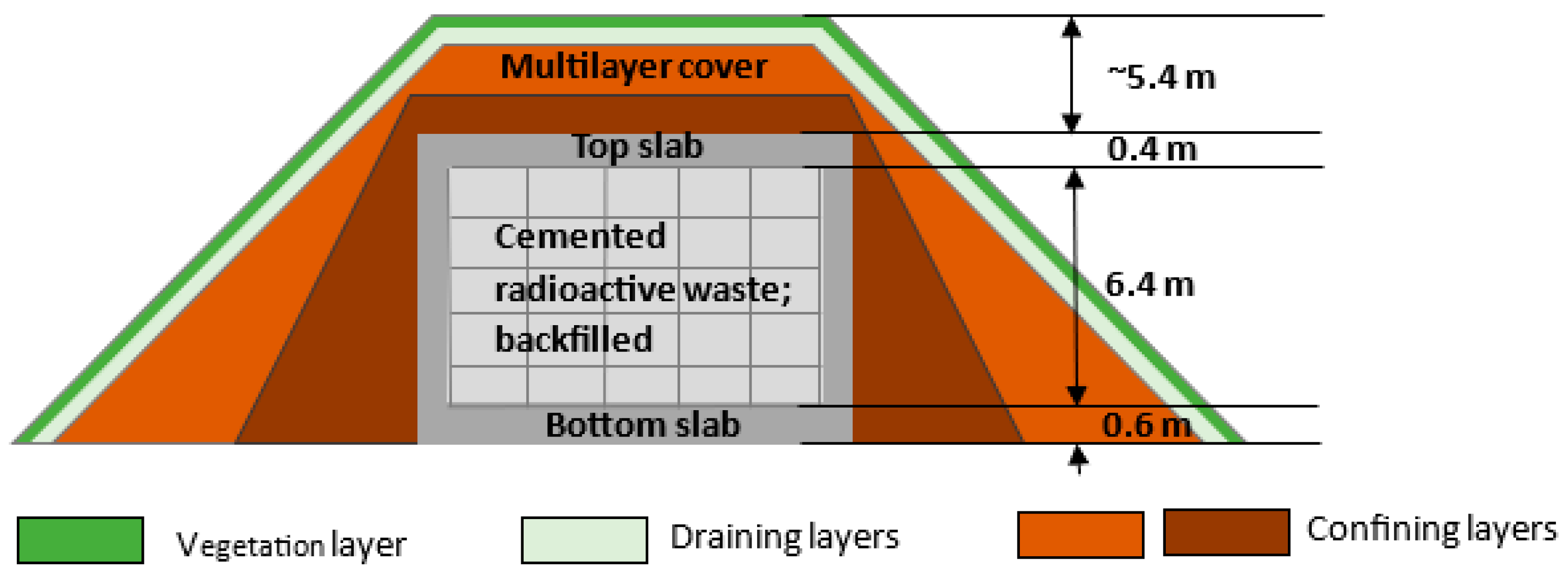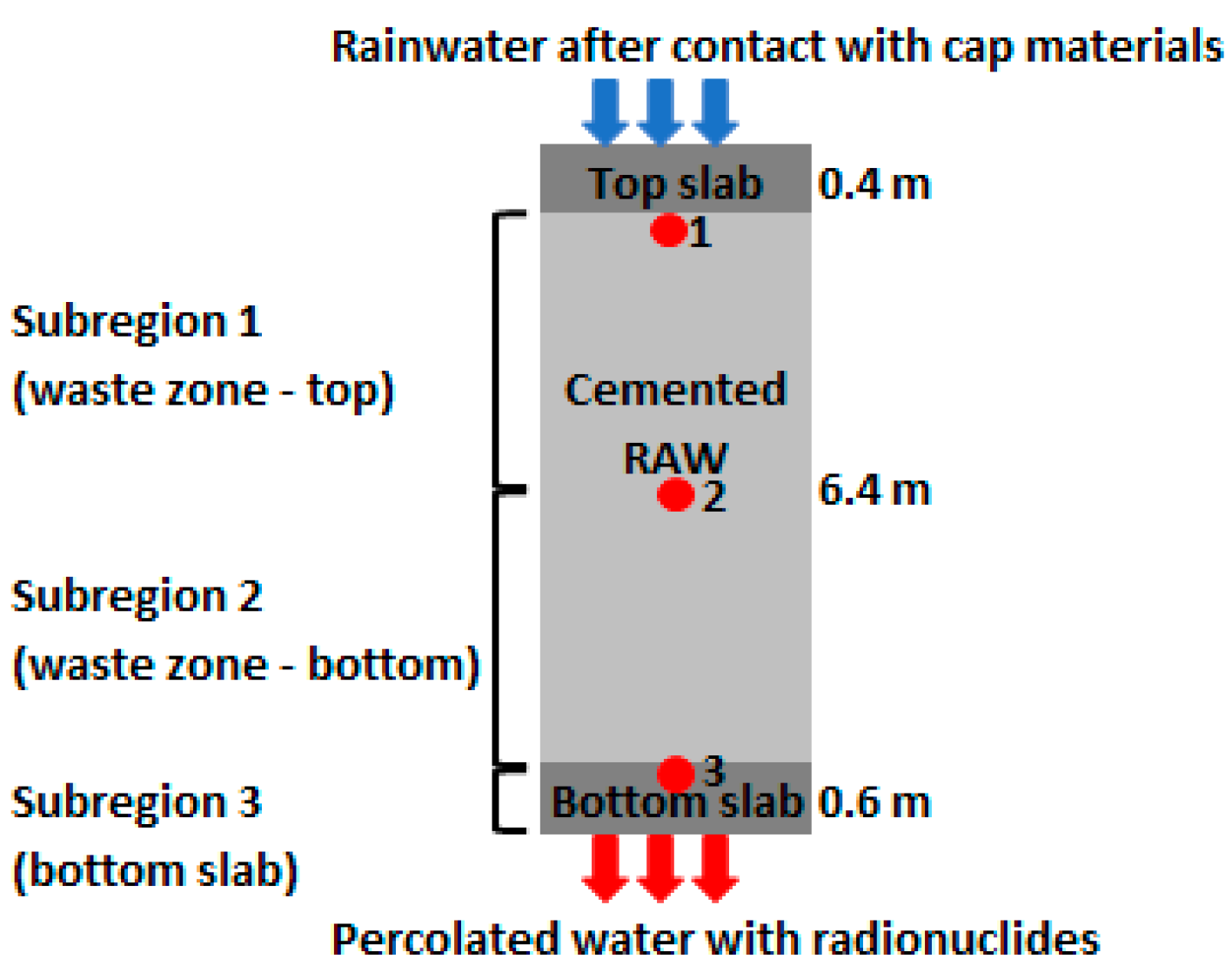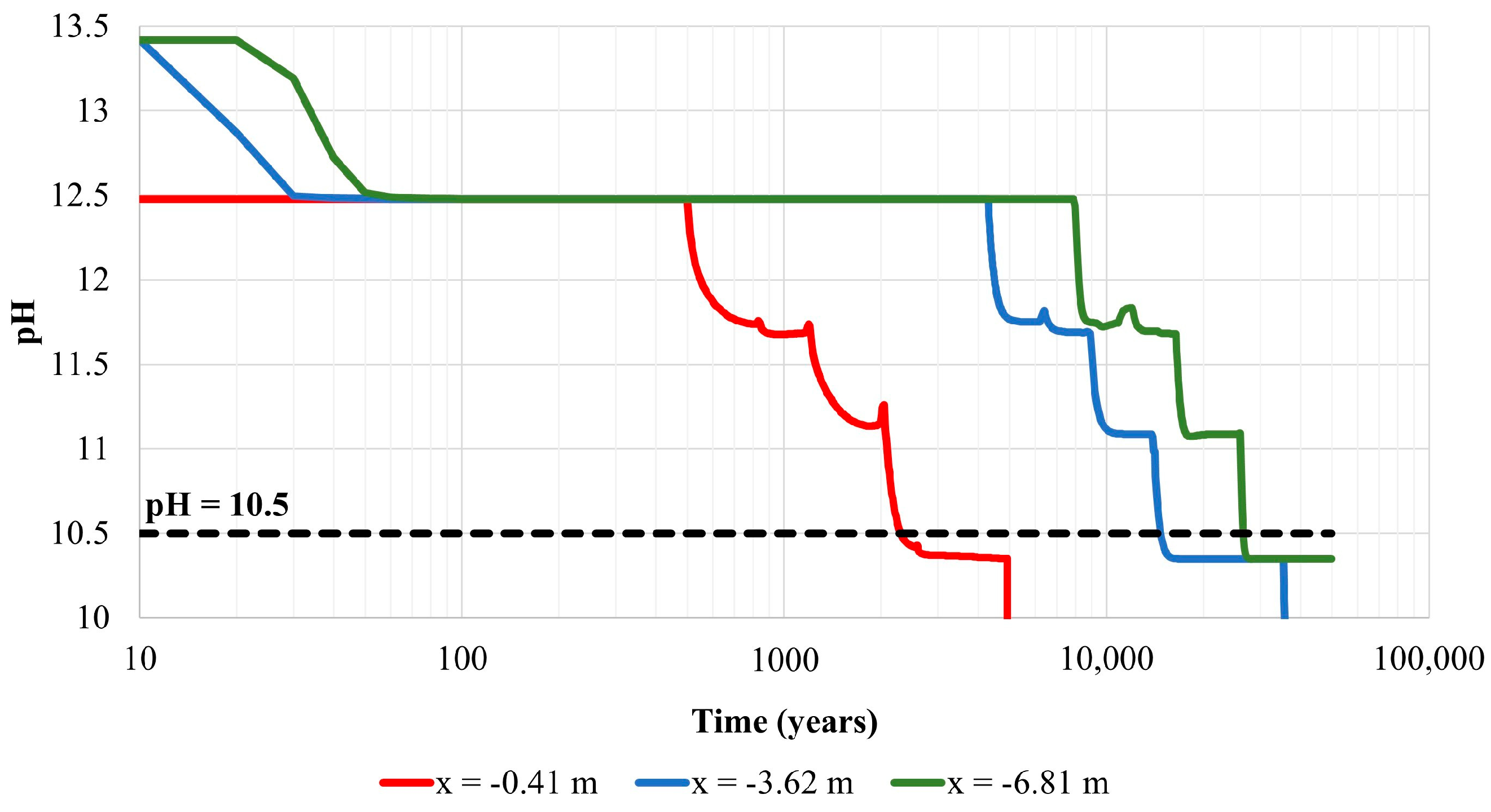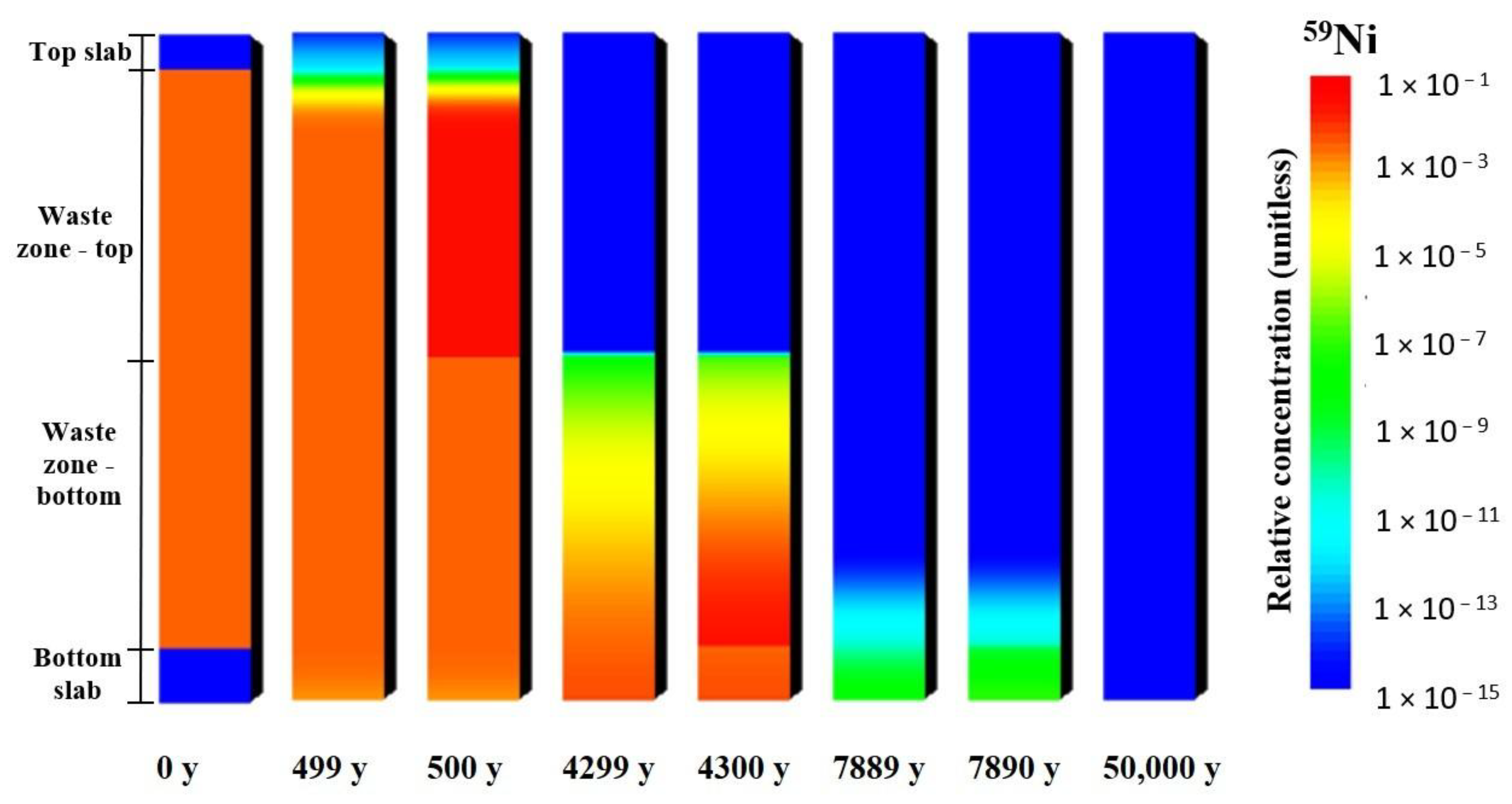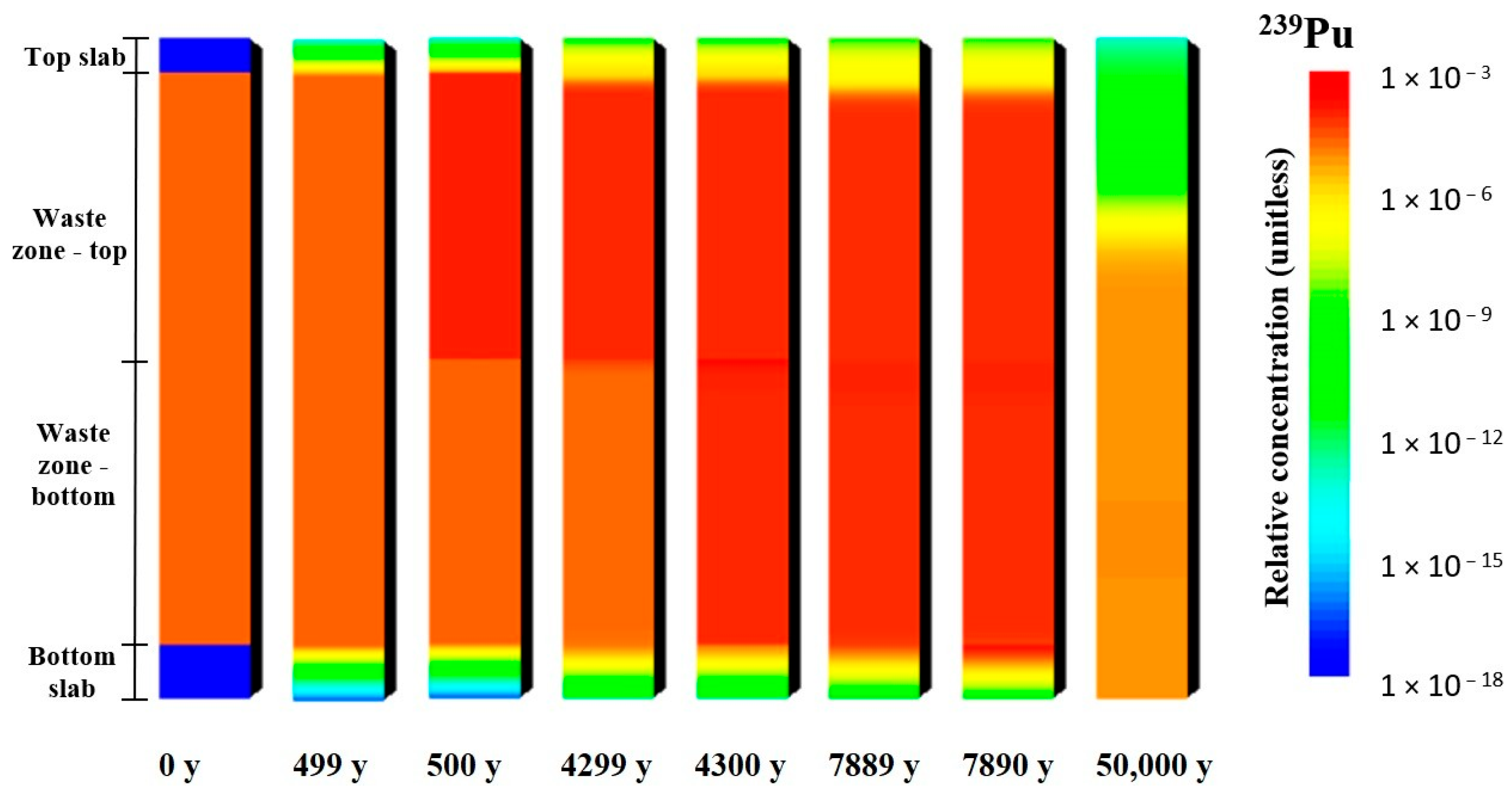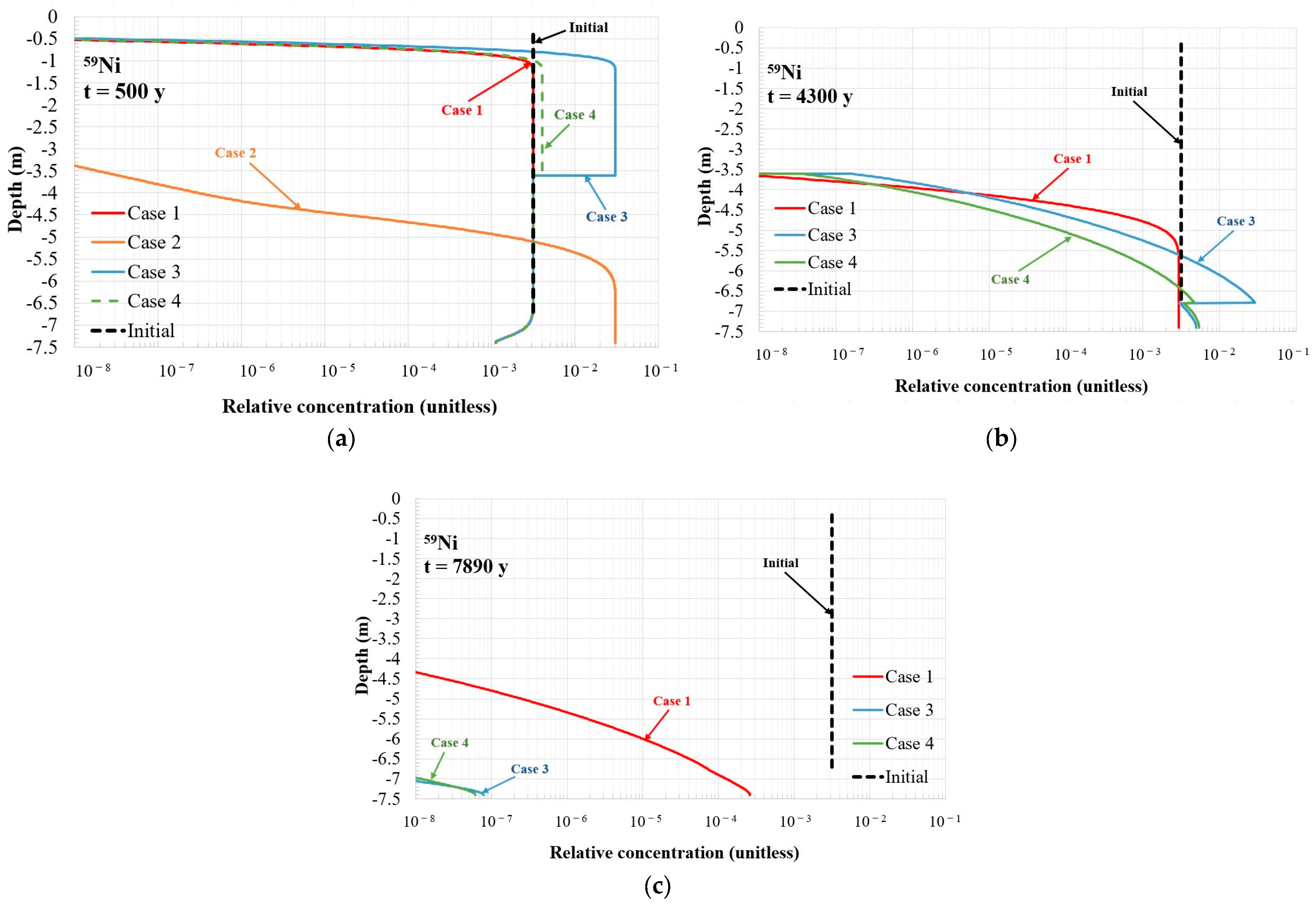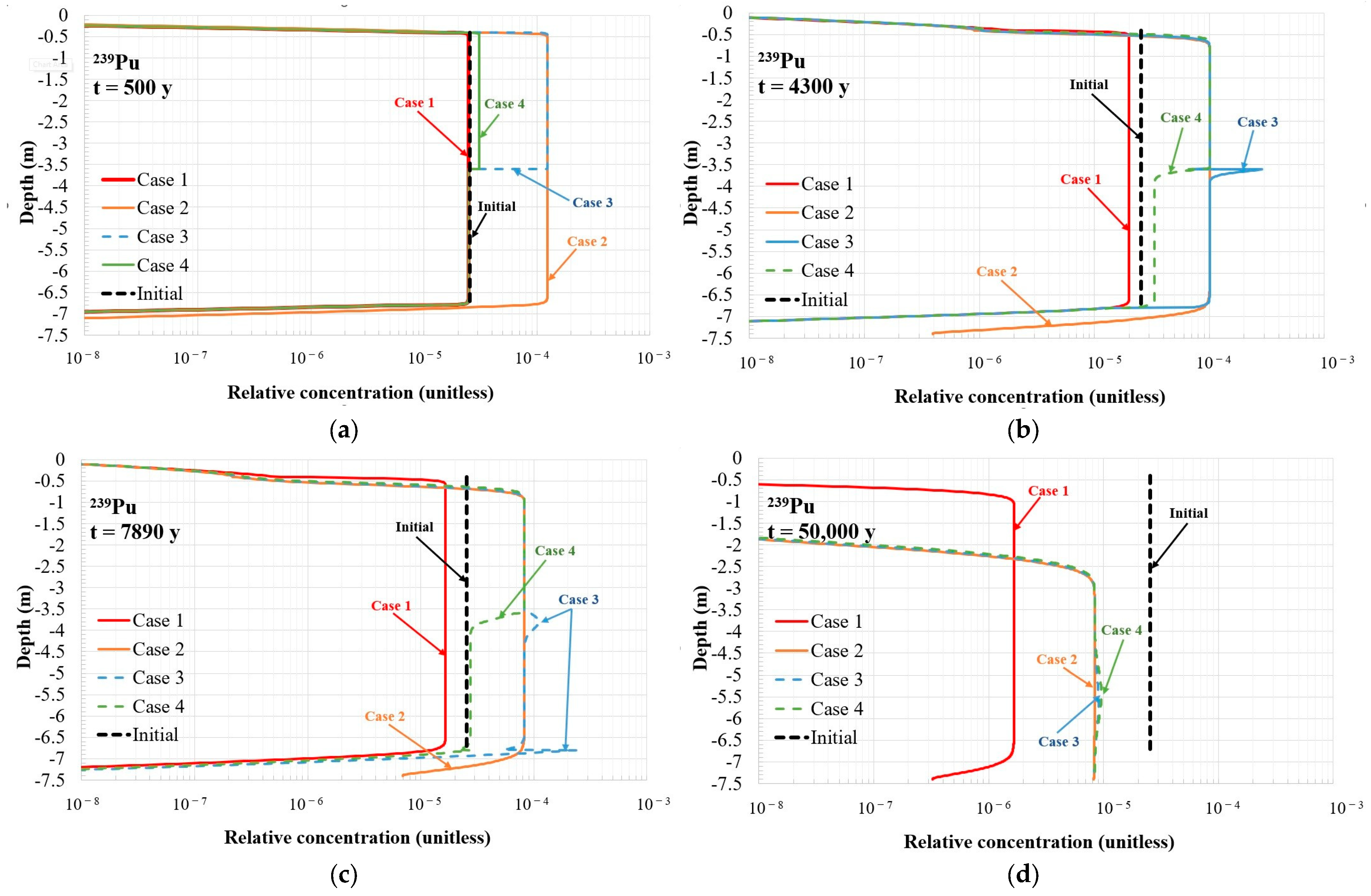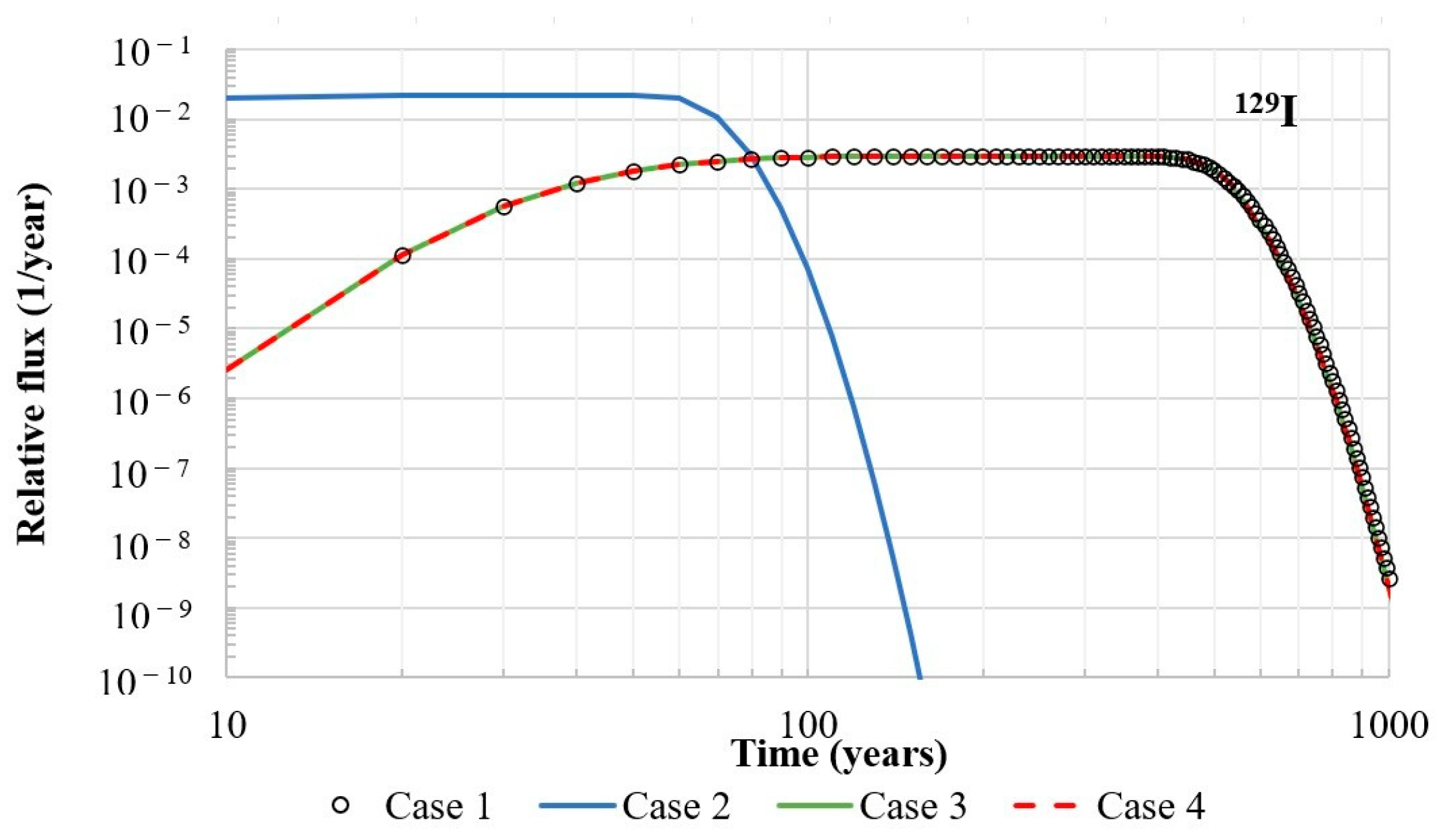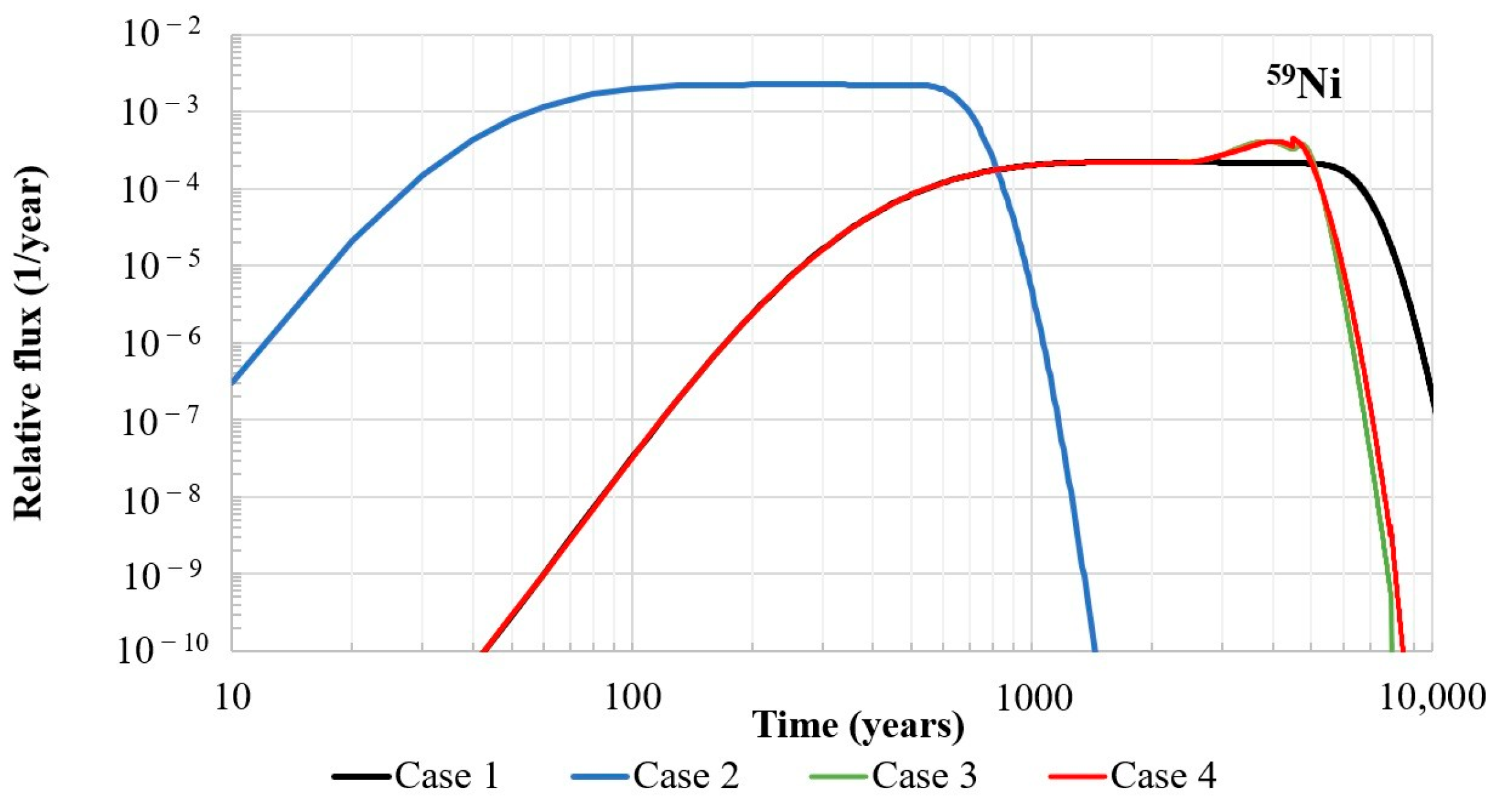3.3. Radionuclide Flux into the Environment
Radionuclide flux from the repository is the basis for the assessment of its impact on humans (and non-human biota). This section provides a comparison of the radionuclide relative fluxes from the NSR between the considered cases 1–4.
Figure 14,
Figure 15 and
Figure 16 present changes in flux over time for radionuclides
129I,
59Ni and
239Pu, respectively. The peak flux and the time of its appearance for each case and radionuclide are summarised in
Table 9.
129I. Cases 1 (constant Kd values as in non-degraded concrete) and 2 (constant Kd values as in degraded concrete) define the bounding intervals of the potential radionuclide relative flux from the repository: case 1 corresponds to the lower limit of relative flux, and case 2 indicates the upper bound. In the case of radionuclide
129I, it can be seen from
Figure 14 that the maximum relative flux in case 2 is about 2 × 10
−2 1/y, and it is higher than the maximum relative flux in case 1 by a factor of 7. In addition, the flux line in case 1 (Kd value as in non-degraded concrete) is shifted to later times by a few hundred years. It can be noticed that the relative flux in cases 3 and 4 coincides with that in case 1. The maximum relative flux in this case is reached at approximately 150 years after repository closure and is slightly less than 3 × 10
−3 1/year (see
Table 9). The flux decreases significantly (by six orders of magnitude) at around 1000 years.
Table 6 and
Table 7 show that the first changes in the Kd values occur in the upper part of the waste zone at around 500 years. However, there is no significant increase in relative flux by this time. This confirms the results obtained from the relative concentration profiles: the increase in the Kd value in the upper part of the waste zone has an insignificant impact on the relative flux, as the increase in the Kd value occurs at a time at which
129I has almost been leached out. Similarly, the increase in the Kd value at the bottom part of the waste zone occurs when the relative flux has already decreased significantly. This means that the degradation of the concrete barriers has an insignificant impact on
129I release from the repository. This is also in line with the relative concentration profiles, as discussed in
Section 3.2. These findings indicate that, for long-lived mobile radionuclides, the chemical degradation of concrete barriers is of minor importance because the larger part of the inventory is transported out of the repository before the effect of concrete degradation manifests.
59Ni.
59Ni is a moderately sorbed radionuclide. The difference in the maximum relative flux from the repository between the bounding cases, case 1 and case 2, for
59Ni is about one order of magnitude (see
Figure 15). Similarly to radionuclide
129I, the relative flux of
59Ni in cases 1, 3 and 4 is the same for about 4000 years. After this point, a difference in the release of
59Ni into the environment is observed between case 1 and cases 3 and 4. The changes in the Kd values in the upper part of the waste zone correspond to the first peak in relative flux; see
Figure 15, case 3 and case 4. Due to the moderate sorption of
59Ni and the distance from the upper part of the waste zone to the release point (bottom of the repository), the effect of this change is shifted in time, and the maximum relative flux is reached by around 4000 years after repository closure. The second peak in relative flux in cases 3 and 4 is observed approximately 600 years later. This peak is attributed to the degradation of the bottom part of the waste zone. The changes in relative flux in cases 3 and 4 follow the changes in the relative concentration over time at the top of the vault bottom slab (see
Figure 10b). The difference is that the increases in the flux are not so sharp and are more extended in time. The last peak in
59Ni release from the repository can be expected when the bottom slab degrades. It can be seen from
Figure 15 that the relative flux of
59Ni decreases significantly a few thousand years after the second peak in cases 3 and 4. Therefore, similarly to radionuclide
129I, the Kd change in the bottom slab has only a minor effect on
59Ni flux.
The observed differences in 59Ni relative flux from the repository indicate that, for long-lived, moderately sorbed radionuclides, the degradation of cementitious barriers and, consequently, changes in their ability to retard radionuclides could be important factors when performing safety assessments of the NSR. The maximum relative flux from the repository with constant Kd values, as in non-degraded concrete (case 1), can lead to the underestimation of the radionuclide flux into the environment. The inclusion of concrete degradation effects in the analysed system led to a relative flux that was twice as high as in case 1. On the other hand, the assessment of the repository’s safety when assuming constant Kd values, as in degraded concrete (case 2), gives very conservative estimations (for the system under consideration, the difference in relative flux in case 2 and case 3 was a factor of 5), which could lead to the inefficient use of resources and higher costs while planning radioactive waste disposal.
239Pu. Differences between the approaches implemented in the model to represent the degradation of cementitious materials in the repository and, consequently, changes in their ability to sorb radionuclides can be clearly observed when analysing the relative flux into the environment for the well-sorbed radionuclide
239Pu—see
Figure 16. At first, it can be noticed that the peaks in relative flux from the repository in the bounding cases, case 1 and case 2, are reached significantly later compared to other analysed radionuclides (see
Table 9). When constant Kd values, as in non-degraded concrete, are assumed over the modelled period (case 1), the maximum relative flux of
239Pu is reached after more than 50,000 years. Assuming constant Kd values, corresponding to degraded concrete (case 2), the maximum flux may occur in less than 20,000 years. The difference in the relative flux peak values between case 1 and case 2 is about two orders or magnitude. It should also be noted that the peak in relative flux from the repository in cases 3 and 4 is closer to that in case 2 in terms of its magnitude and time of appearance, and this is different from the case of radionuclide
59Ni, where the peaks in cases 3 and 4 were closer to that in case 1.
An analysis of the relative flux of
239Pu in case 3 (the case with a single degradation step for each subregion, as presented in
Figure 3) indicates a sharp increase at about 8000 years after repository closure, which coincides with the decrease in
239Pu sorption in the concrete slab (see
Figure 16). As the bottom slab is the last barrier before entering the surrounding environment, there is almost no delay in the change in the Kd value and the increase in the relative flux of
239Pu. The peak in relative flux in case 3 is about 2 × 10
−6 1/y (about 15% lower compared to case 2) and appears at about 22,000 years after repository closure.
Several stepwise increases in
239Pu’s relative flux are observed in case 4, as shown in
Figure 16, indicating the more gradual chemical degradation of concrete compared to case 3. The peak in relative flux is reached by around 27,000 years and is about 1.9 × 10
−6 1/y, which is about 20% lower than in case 2. The clearly visible increase in relative flux at around 8000 years and the two increases between 10,000 and 20,000 years correspond to the gradual degradation of the concrete slab. There are also very small peaks, which are almost undetectable, shortly after 8000 years and at around 9000 years, which are related to the final degradation of the bottom part of the waste zone. The increase in the
239Pu concentration in the bottom part of the waste zone has only a minor effect, as the released
239Pu must migrate through the bottom slab, which still retains its initial sorption capacity for radionuclides. This significantly delays the translation of the concentration increase into an increase in relative flux. It should be noted that radioactive decay could also play a significant role over such long time frames.
The findings from the modelling of 239Pu migration indicate that changes in the Kd values within the waste zone are of lesser importance for the migration of long-lived, well-sorbed radionuclides, at least while the bottom barriers retain their initial sorptive properties. The radioactive waste zone is a very complex part of the repository, with different types of waste, containers, waste immobilisation and vault backfill materials. Therefore, it is a challenging task to define the appropriate sorption value representing radionuclide sorption in this zone. The obtained results suggest that, for the safety assessment of the repository, the selection of a conservative Kd value in the waste zone for long-lived, well-sorbed radionuclides could be a reasonable option, and further efforts are needed regarding the specification of the bottom barrier’s properties.
The comparison of radionuclides based on their relative flux sensitivity to concrete degradation indicates that
129I flux is insensitive to concrete degradation (see
Figure 14 and
Table 9). The leaching of concrete minerals is a slow process, and the weakly sorbed
129I is transported out of the repository before the effect of concrete degradation becomes significant. Therefore, the relative flux of
129I remains the same as that when assuming non-degrading concrete.
The fluxes of radionuclides
59Ni and
239Pu are both affected by concrete degradation, although to different extents. For the moderately sorbed radionuclide
59Ni, the effect of concrete degradation occurs when radionuclide release has reached a plateau and a large amount of the inventory has already been leached. Consequently, the increase in flux after the update of the Kd values is limited—it is approximately twice as high as in the case of non-degraded concrete (see
Table 9).
239Pu is released from the repository very slowly due to its strong sorption in concrete. The degradation of the concrete barriers occurs before the peak in 239Pu flux is reached, meaning that a large amount of 239Pu is still present in the repository. Consequently, after concrete degradation and the associated decrease in sorption, the 239Pu flux rapidly increases to a peak value, which is similar to that for constant sorption in the case of degraded concrete and about two orders of magnitude higher than that for constant sorption in the case of non-degraded concrete.
The radionuclides analysed in this study represent weakly, moderately and strongly sorbed radionuclides on cementitious materials. The results obtained may indicate trends in the migration of other radionuclides that exhibit similar changes in Kd values during concrete degradation. The behaviour of weakly sorbing radionuclides, such as 99Tc, is expected to be similar to that of 129I, whereas the migration of strongly sorbing radionuclides, such as U and Nb, is expected to resemble that of Pu. However, it should be noted that each disposal system is unique, and radionuclide sorption may evolve differently as concrete degrades. Therefore, the results should be interpreted with caution.
